Comprehensive Health Assessment Interview Report: Respiratory Patient
VerifiedAdded on 2022/08/25
|7
|1499
|29
Report
AI Summary
This report details a health assessment interview conducted by a student nurse on a patient experiencing respiratory problems. The report outlines the interview questions used to gather patient history, including symptoms, medical history, and lifestyle factors. It then describes the IPPA (Inspectio...
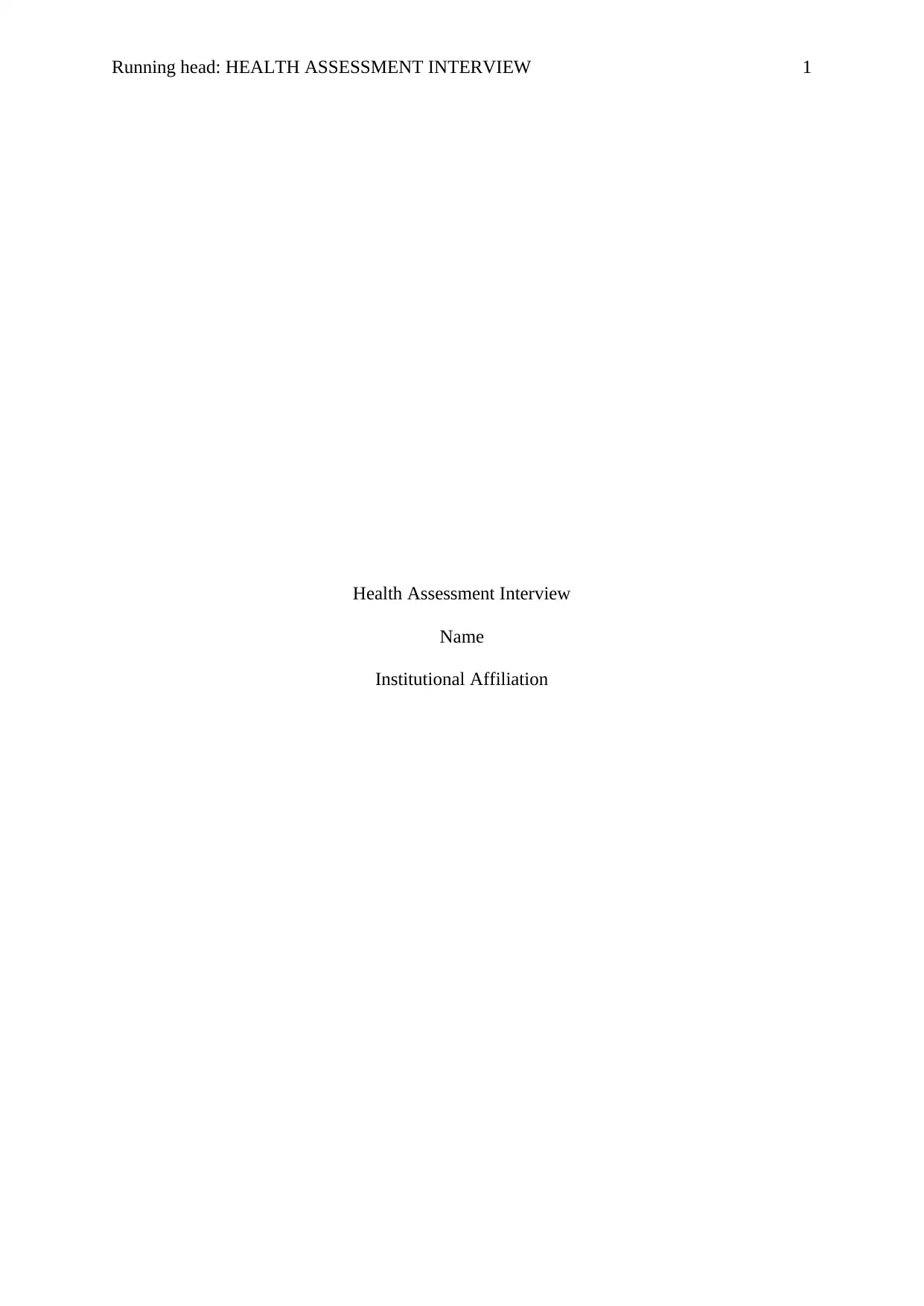
Running head: HEALTH ASSESSMENT INTERVIEW 1
Health Assessment Interview
Name
Institutional Affiliation
Health Assessment Interview
Name
Institutional Affiliation
Paraphrase This Document
Need a fresh take? Get an instant paraphrase of this document with our AI Paraphraser
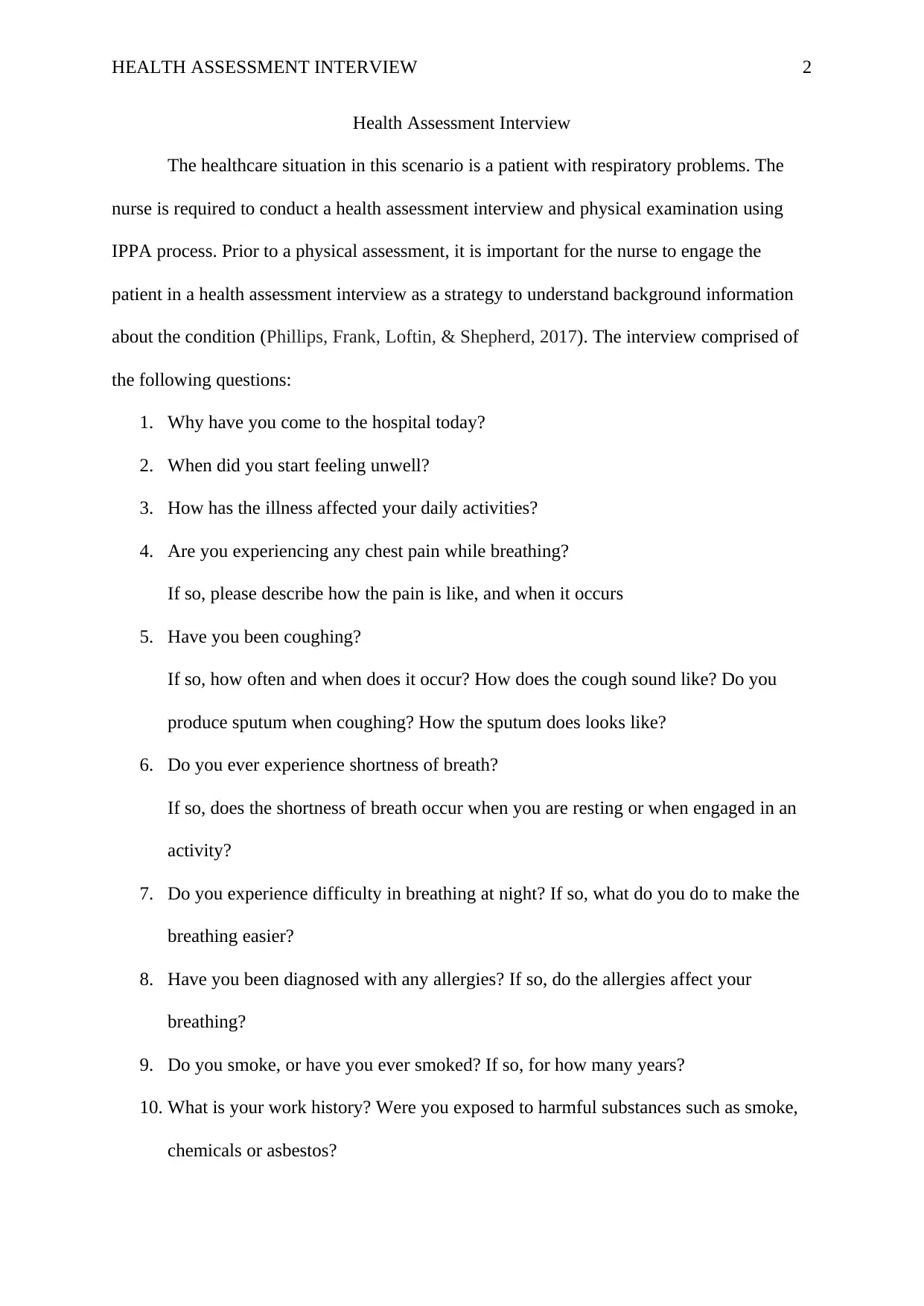
HEALTH ASSESSMENT INTERVIEW 2
Health Assessment Interview
The healthcare situation in this scenario is a patient with respiratory problems. The
nurse is required to conduct a health assessment interview and physical examination using
IPPA process. Prior to a physical assessment, it is important for the nurse to engage the
patient in a health assessment interview as a strategy to understand background information
about the condition (Phillips, Frank, Loftin, & Shepherd, 2017). The interview comprised of
the following questions:
1. Why have you come to the hospital today?
2. When did you start feeling unwell?
3. How has the illness affected your daily activities?
4. Are you experiencing any chest pain while breathing?
If so, please describe how the pain is like, and when it occurs
5. Have you been coughing?
If so, how often and when does it occur? How does the cough sound like? Do you
produce sputum when coughing? How the sputum does looks like?
6. Do you ever experience shortness of breath?
If so, does the shortness of breath occur when you are resting or when engaged in an
activity?
7. Do you experience difficulty in breathing at night? If so, what do you do to make the
breathing easier?
8. Have you been diagnosed with any allergies? If so, do the allergies affect your
breathing?
9. Do you smoke, or have you ever smoked? If so, for how many years?
10. What is your work history? Were you exposed to harmful substances such as smoke,
chemicals or asbestos?
Health Assessment Interview
The healthcare situation in this scenario is a patient with respiratory problems. The
nurse is required to conduct a health assessment interview and physical examination using
IPPA process. Prior to a physical assessment, it is important for the nurse to engage the
patient in a health assessment interview as a strategy to understand background information
about the condition (Phillips, Frank, Loftin, & Shepherd, 2017). The interview comprised of
the following questions:
1. Why have you come to the hospital today?
2. When did you start feeling unwell?
3. How has the illness affected your daily activities?
4. Are you experiencing any chest pain while breathing?
If so, please describe how the pain is like, and when it occurs
5. Have you been coughing?
If so, how often and when does it occur? How does the cough sound like? Do you
produce sputum when coughing? How the sputum does looks like?
6. Do you ever experience shortness of breath?
If so, does the shortness of breath occur when you are resting or when engaged in an
activity?
7. Do you experience difficulty in breathing at night? If so, what do you do to make the
breathing easier?
8. Have you been diagnosed with any allergies? If so, do the allergies affect your
breathing?
9. Do you smoke, or have you ever smoked? If so, for how many years?
10. What is your work history? Were you exposed to harmful substances such as smoke,
chemicals or asbestos?
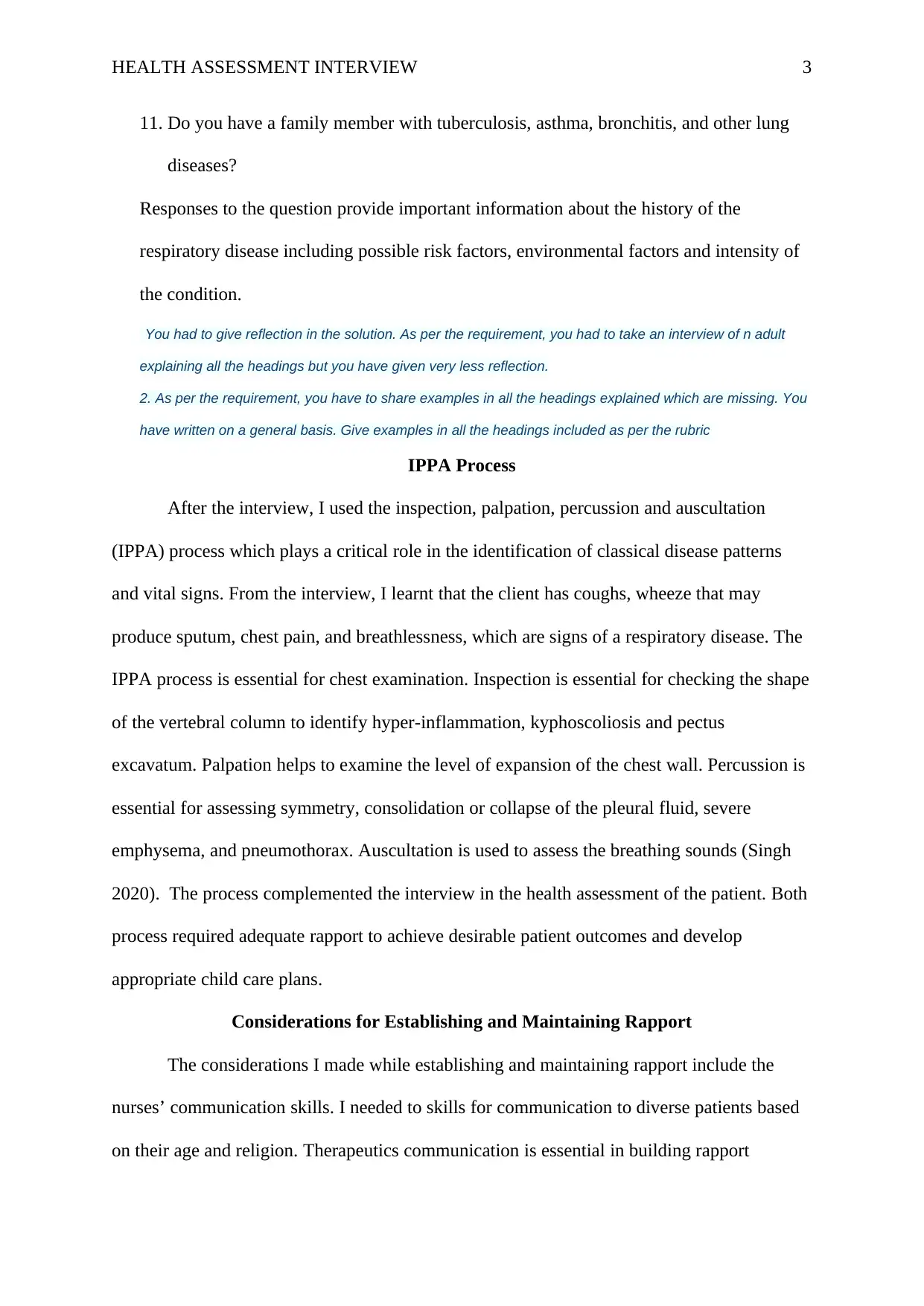
HEALTH ASSESSMENT INTERVIEW 3
11. Do you have a family member with tuberculosis, asthma, bronchitis, and other lung
diseases?
Responses to the question provide important information about the history of the
respiratory disease including possible risk factors, environmental factors and intensity of
the condition.
You had to give reflection in the solution. As per the requirement, you had to take an interview of n adult
explaining all the headings but you have given very less reflection.
2. As per the requirement, you have to share examples in all the headings explained which are missing. You
have written on a general basis. Give examples in all the headings included as per the rubric
IPPA Process
After the interview, I used the inspection, palpation, percussion and auscultation
(IPPA) process which plays a critical role in the identification of classical disease patterns
and vital signs. From the interview, I learnt that the client has coughs, wheeze that may
produce sputum, chest pain, and breathlessness, which are signs of a respiratory disease. The
IPPA process is essential for chest examination. Inspection is essential for checking the shape
of the vertebral column to identify hyper-inflammation, kyphoscoliosis and pectus
excavatum. Palpation helps to examine the level of expansion of the chest wall. Percussion is
essential for assessing symmetry, consolidation or collapse of the pleural fluid, severe
emphysema, and pneumothorax. Auscultation is used to assess the breathing sounds (Singh
2020). The process complemented the interview in the health assessment of the patient. Both
process required adequate rapport to achieve desirable patient outcomes and develop
appropriate child care plans.
Considerations for Establishing and Maintaining Rapport
The considerations I made while establishing and maintaining rapport include the
nurses’ communication skills. I needed to skills for communication to diverse patients based
on their age and religion. Therapeutics communication is essential in building rapport
11. Do you have a family member with tuberculosis, asthma, bronchitis, and other lung
diseases?
Responses to the question provide important information about the history of the
respiratory disease including possible risk factors, environmental factors and intensity of
the condition.
You had to give reflection in the solution. As per the requirement, you had to take an interview of n adult
explaining all the headings but you have given very less reflection.
2. As per the requirement, you have to share examples in all the headings explained which are missing. You
have written on a general basis. Give examples in all the headings included as per the rubric
IPPA Process
After the interview, I used the inspection, palpation, percussion and auscultation
(IPPA) process which plays a critical role in the identification of classical disease patterns
and vital signs. From the interview, I learnt that the client has coughs, wheeze that may
produce sputum, chest pain, and breathlessness, which are signs of a respiratory disease. The
IPPA process is essential for chest examination. Inspection is essential for checking the shape
of the vertebral column to identify hyper-inflammation, kyphoscoliosis and pectus
excavatum. Palpation helps to examine the level of expansion of the chest wall. Percussion is
essential for assessing symmetry, consolidation or collapse of the pleural fluid, severe
emphysema, and pneumothorax. Auscultation is used to assess the breathing sounds (Singh
2020). The process complemented the interview in the health assessment of the patient. Both
process required adequate rapport to achieve desirable patient outcomes and develop
appropriate child care plans.
Considerations for Establishing and Maintaining Rapport
The considerations I made while establishing and maintaining rapport include the
nurses’ communication skills. I needed to skills for communication to diverse patients based
on their age and religion. Therapeutics communication is essential in building rapport
⊘ This is a preview!⊘
Do you want full access?
Subscribe today to unlock all pages.

Trusted by 1+ million students worldwide
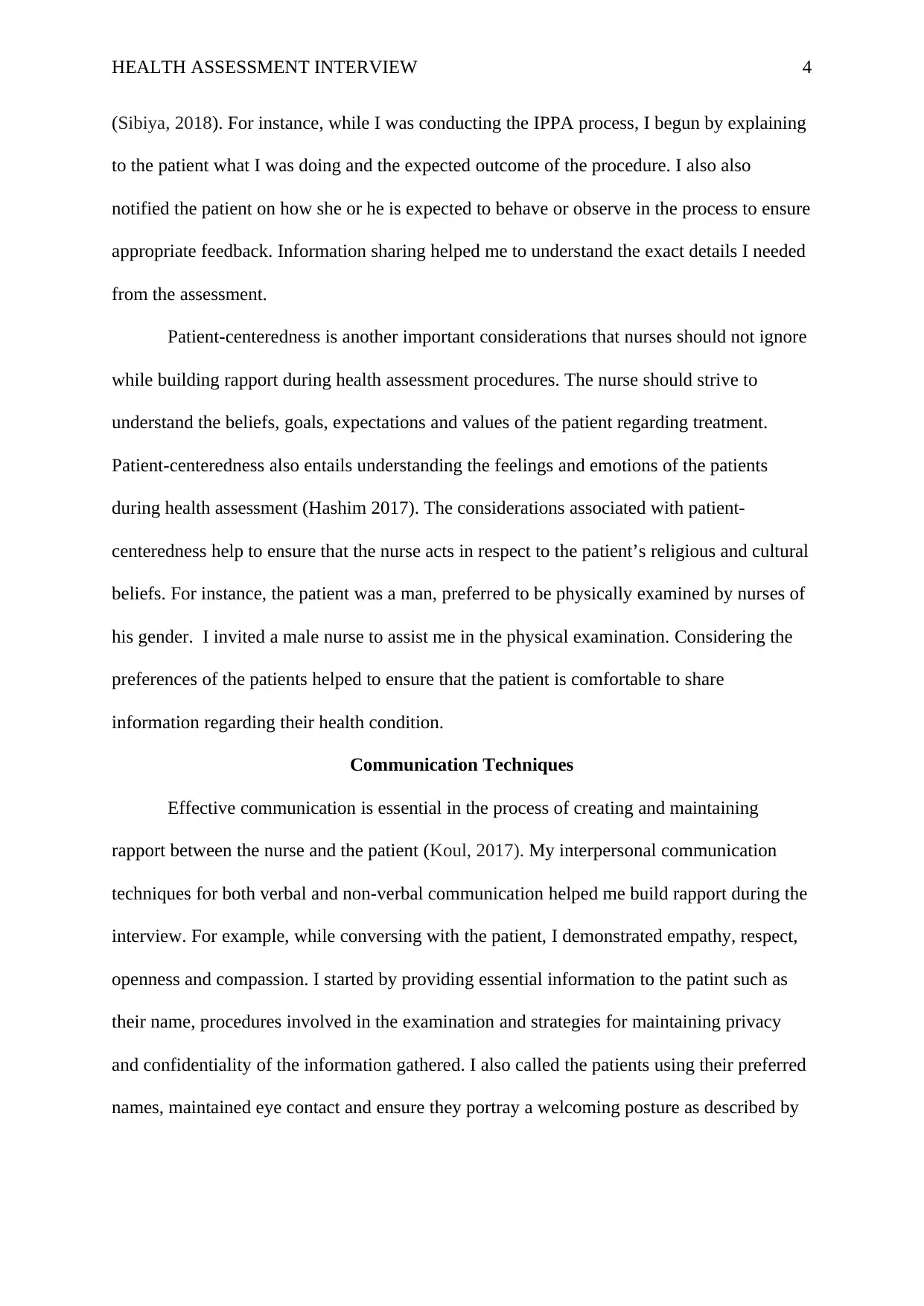
HEALTH ASSESSMENT INTERVIEW 4
(Sibiya, 2018). For instance, while I was conducting the IPPA process, I begun by explaining
to the patient what I was doing and the expected outcome of the procedure. I also also
notified the patient on how she or he is expected to behave or observe in the process to ensure
appropriate feedback. Information sharing helped me to understand the exact details I needed
from the assessment.
Patient-centeredness is another important considerations that nurses should not ignore
while building rapport during health assessment procedures. The nurse should strive to
understand the beliefs, goals, expectations and values of the patient regarding treatment.
Patient-centeredness also entails understanding the feelings and emotions of the patients
during health assessment (Hashim 2017). The considerations associated with patient-
centeredness help to ensure that the nurse acts in respect to the patient’s religious and cultural
beliefs. For instance, the patient was a man, preferred to be physically examined by nurses of
his gender. I invited a male nurse to assist me in the physical examination. Considering the
preferences of the patients helped to ensure that the patient is comfortable to share
information regarding their health condition.
Communication Techniques
Effective communication is essential in the process of creating and maintaining
rapport between the nurse and the patient (Koul, 2017). My interpersonal communication
techniques for both verbal and non-verbal communication helped me build rapport during the
interview. For example, while conversing with the patient, I demonstrated empathy, respect,
openness and compassion. I started by providing essential information to the patint such as
their name, procedures involved in the examination and strategies for maintaining privacy
and confidentiality of the information gathered. I also called the patients using their preferred
names, maintained eye contact and ensure they portray a welcoming posture as described by
(Sibiya, 2018). For instance, while I was conducting the IPPA process, I begun by explaining
to the patient what I was doing and the expected outcome of the procedure. I also also
notified the patient on how she or he is expected to behave or observe in the process to ensure
appropriate feedback. Information sharing helped me to understand the exact details I needed
from the assessment.
Patient-centeredness is another important considerations that nurses should not ignore
while building rapport during health assessment procedures. The nurse should strive to
understand the beliefs, goals, expectations and values of the patient regarding treatment.
Patient-centeredness also entails understanding the feelings and emotions of the patients
during health assessment (Hashim 2017). The considerations associated with patient-
centeredness help to ensure that the nurse acts in respect to the patient’s religious and cultural
beliefs. For instance, the patient was a man, preferred to be physically examined by nurses of
his gender. I invited a male nurse to assist me in the physical examination. Considering the
preferences of the patients helped to ensure that the patient is comfortable to share
information regarding their health condition.
Communication Techniques
Effective communication is essential in the process of creating and maintaining
rapport between the nurse and the patient (Koul, 2017). My interpersonal communication
techniques for both verbal and non-verbal communication helped me build rapport during the
interview. For example, while conversing with the patient, I demonstrated empathy, respect,
openness and compassion. I started by providing essential information to the patint such as
their name, procedures involved in the examination and strategies for maintaining privacy
and confidentiality of the information gathered. I also called the patients using their preferred
names, maintained eye contact and ensure they portray a welcoming posture as described by
Paraphrase This Document
Need a fresh take? Get an instant paraphrase of this document with our AI Paraphraser
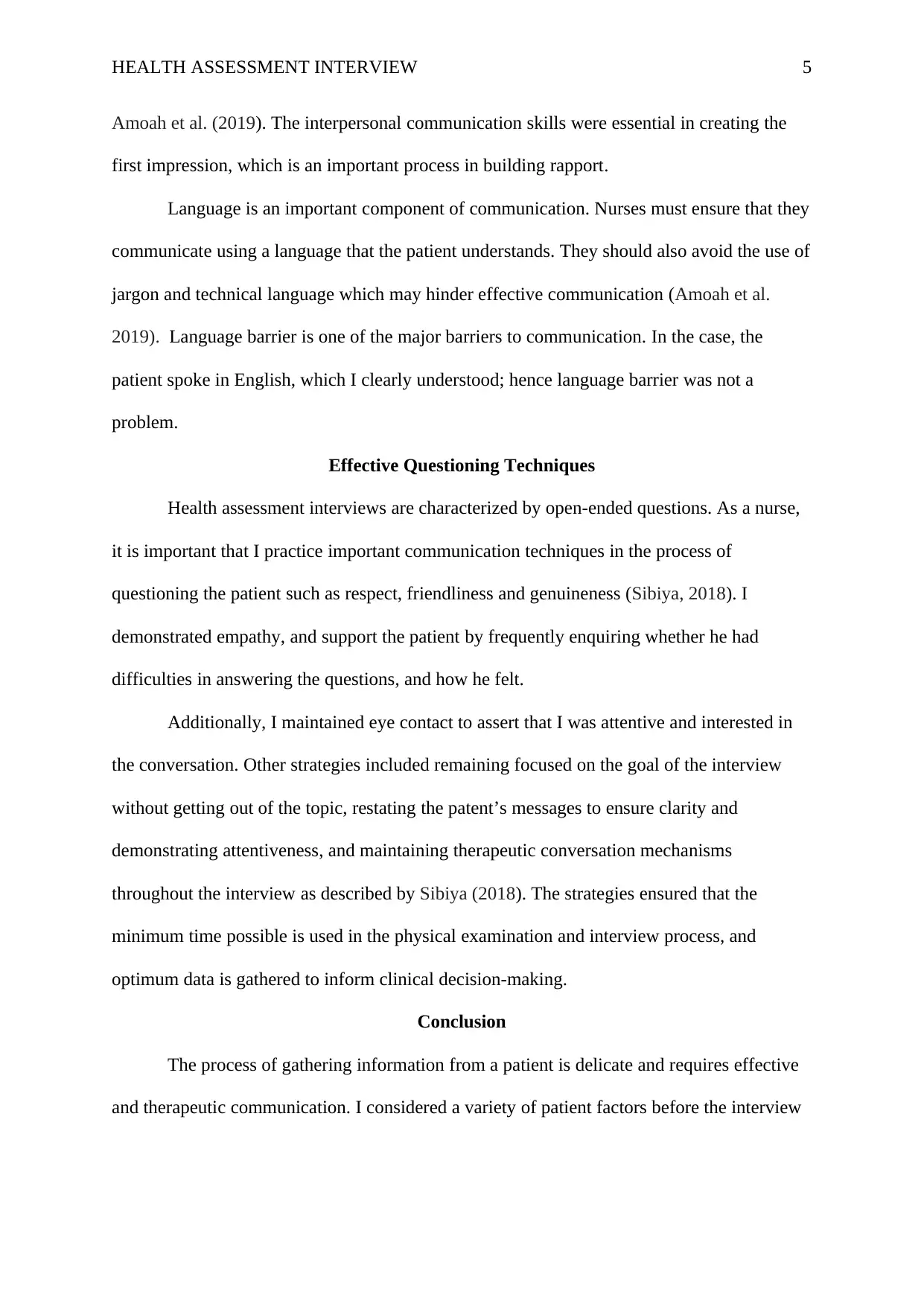
HEALTH ASSESSMENT INTERVIEW 5
Amoah et al. (2019). The interpersonal communication skills were essential in creating the
first impression, which is an important process in building rapport.
Language is an important component of communication. Nurses must ensure that they
communicate using a language that the patient understands. They should also avoid the use of
jargon and technical language which may hinder effective communication (Amoah et al.
2019). Language barrier is one of the major barriers to communication. In the case, the
patient spoke in English, which I clearly understood; hence language barrier was not a
problem.
Effective Questioning Techniques
Health assessment interviews are characterized by open-ended questions. As a nurse,
it is important that I practice important communication techniques in the process of
questioning the patient such as respect, friendliness and genuineness (Sibiya, 2018). I
demonstrated empathy, and support the patient by frequently enquiring whether he had
difficulties in answering the questions, and how he felt.
Additionally, I maintained eye contact to assert that I was attentive and interested in
the conversation. Other strategies included remaining focused on the goal of the interview
without getting out of the topic, restating the patent’s messages to ensure clarity and
demonstrating attentiveness, and maintaining therapeutic conversation mechanisms
throughout the interview as described by Sibiya (2018). The strategies ensured that the
minimum time possible is used in the physical examination and interview process, and
optimum data is gathered to inform clinical decision-making.
Conclusion
The process of gathering information from a patient is delicate and requires effective
and therapeutic communication. I considered a variety of patient factors before the interview
Amoah et al. (2019). The interpersonal communication skills were essential in creating the
first impression, which is an important process in building rapport.
Language is an important component of communication. Nurses must ensure that they
communicate using a language that the patient understands. They should also avoid the use of
jargon and technical language which may hinder effective communication (Amoah et al.
2019). Language barrier is one of the major barriers to communication. In the case, the
patient spoke in English, which I clearly understood; hence language barrier was not a
problem.
Effective Questioning Techniques
Health assessment interviews are characterized by open-ended questions. As a nurse,
it is important that I practice important communication techniques in the process of
questioning the patient such as respect, friendliness and genuineness (Sibiya, 2018). I
demonstrated empathy, and support the patient by frequently enquiring whether he had
difficulties in answering the questions, and how he felt.
Additionally, I maintained eye contact to assert that I was attentive and interested in
the conversation. Other strategies included remaining focused on the goal of the interview
without getting out of the topic, restating the patent’s messages to ensure clarity and
demonstrating attentiveness, and maintaining therapeutic conversation mechanisms
throughout the interview as described by Sibiya (2018). The strategies ensured that the
minimum time possible is used in the physical examination and interview process, and
optimum data is gathered to inform clinical decision-making.
Conclusion
The process of gathering information from a patient is delicate and requires effective
and therapeutic communication. I considered a variety of patient factors before the interview
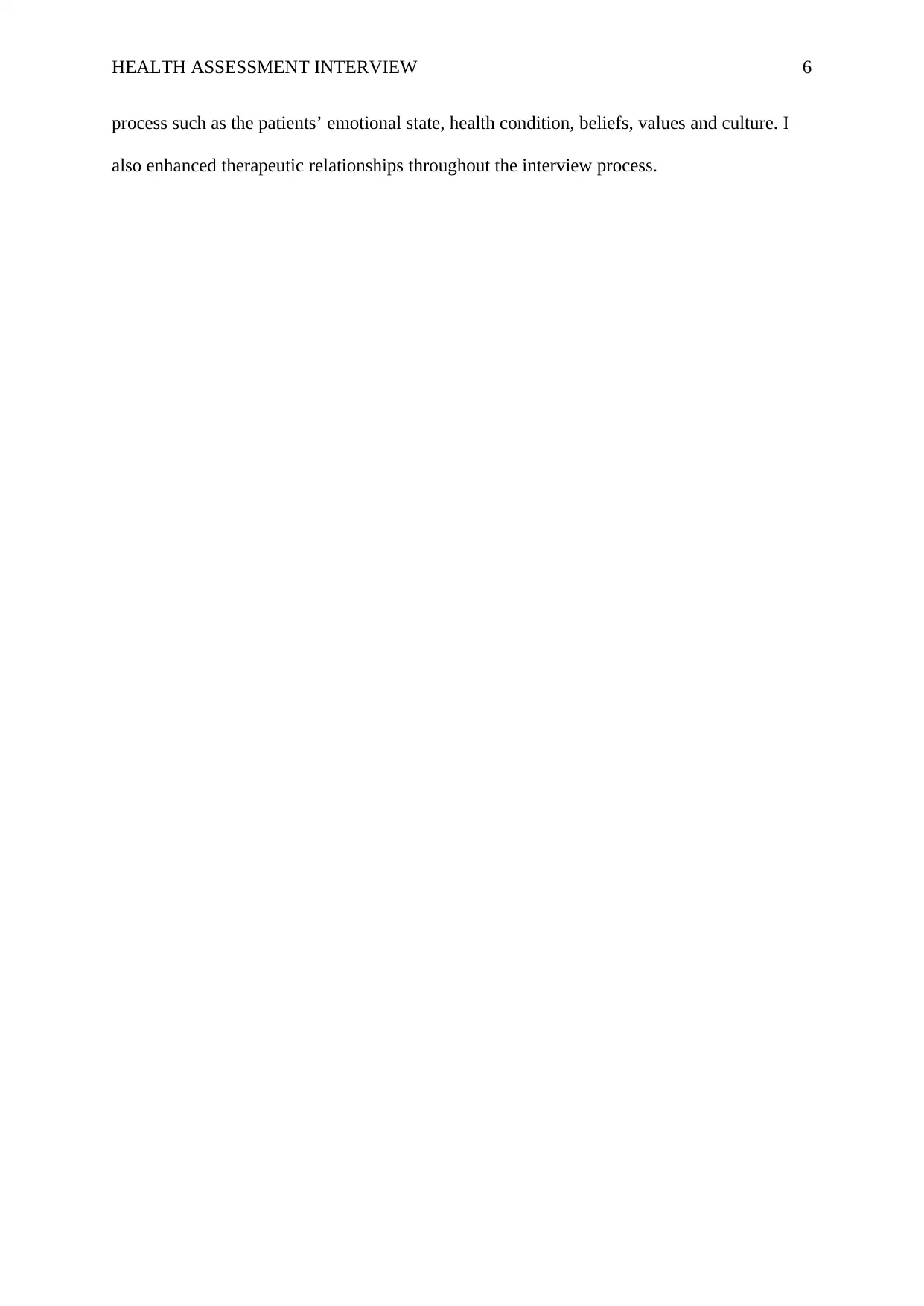
HEALTH ASSESSMENT INTERVIEW 6
process such as the patients’ emotional state, health condition, beliefs, values and culture. I
also enhanced therapeutic relationships throughout the interview process.
process such as the patients’ emotional state, health condition, beliefs, values and culture. I
also enhanced therapeutic relationships throughout the interview process.
⊘ This is a preview!⊘
Do you want full access?
Subscribe today to unlock all pages.

Trusted by 1+ million students worldwide
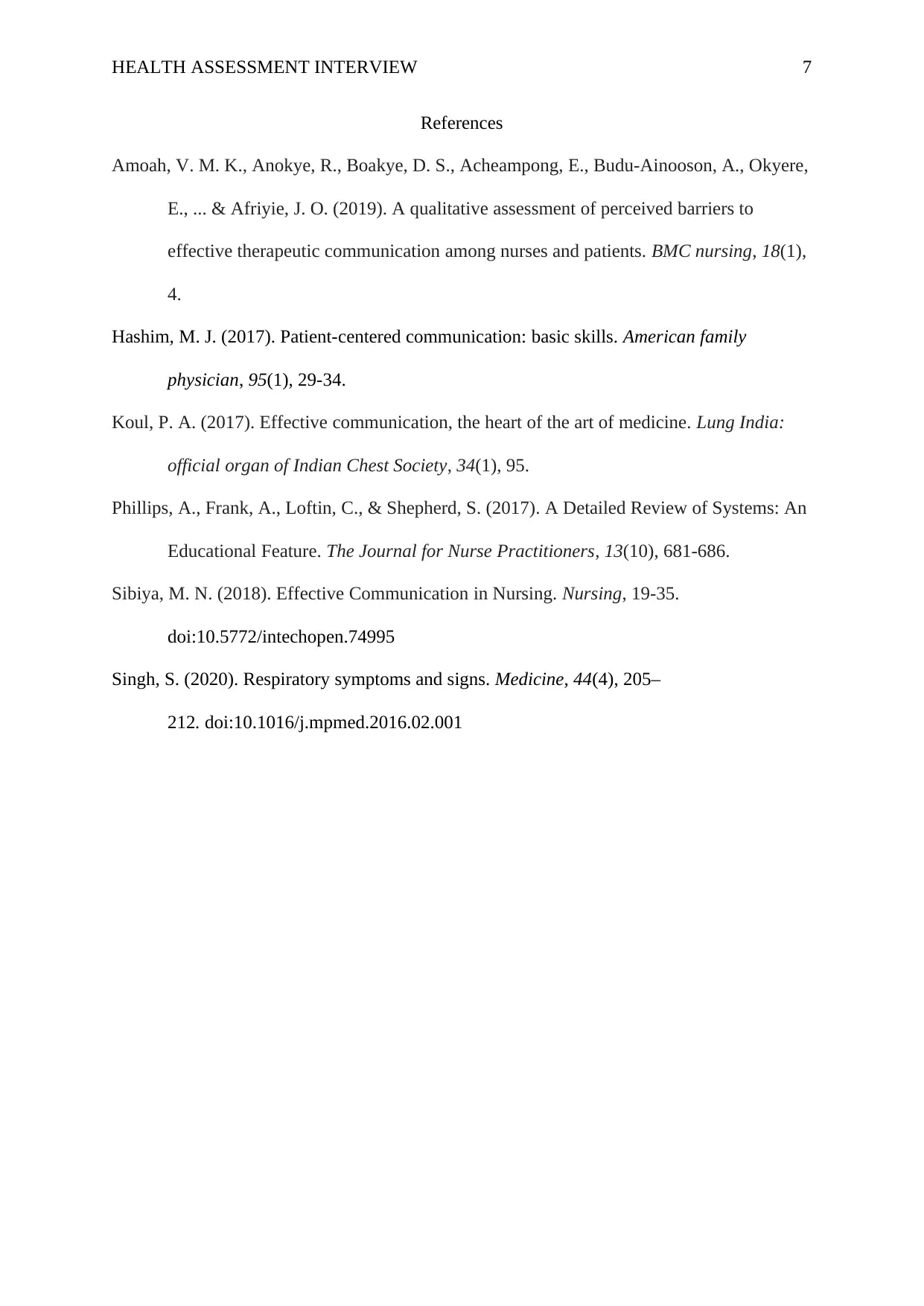
HEALTH ASSESSMENT INTERVIEW 7
References
Amoah, V. M. K., Anokye, R., Boakye, D. S., Acheampong, E., Budu-Ainooson, A., Okyere,
E., ... & Afriyie, J. O. (2019). A qualitative assessment of perceived barriers to
effective therapeutic communication among nurses and patients. BMC nursing, 18(1),
4.
Hashim, M. J. (2017). Patient-centered communication: basic skills. American family
physician, 95(1), 29-34.
Koul, P. A. (2017). Effective communication, the heart of the art of medicine. Lung India:
official organ of Indian Chest Society, 34(1), 95.
Phillips, A., Frank, A., Loftin, C., & Shepherd, S. (2017). A Detailed Review of Systems: An
Educational Feature. The Journal for Nurse Practitioners, 13(10), 681-686.
Sibiya, M. N. (2018). Effective Communication in Nursing. Nursing, 19-35.
doi:10.5772/intechopen.74995
Singh, S. (2020). Respiratory symptoms and signs. Medicine, 44(4), 205–
212. doi:10.1016/j.mpmed.2016.02.001
References
Amoah, V. M. K., Anokye, R., Boakye, D. S., Acheampong, E., Budu-Ainooson, A., Okyere,
E., ... & Afriyie, J. O. (2019). A qualitative assessment of perceived barriers to
effective therapeutic communication among nurses and patients. BMC nursing, 18(1),
4.
Hashim, M. J. (2017). Patient-centered communication: basic skills. American family
physician, 95(1), 29-34.
Koul, P. A. (2017). Effective communication, the heart of the art of medicine. Lung India:
official organ of Indian Chest Society, 34(1), 95.
Phillips, A., Frank, A., Loftin, C., & Shepherd, S. (2017). A Detailed Review of Systems: An
Educational Feature. The Journal for Nurse Practitioners, 13(10), 681-686.
Sibiya, M. N. (2018). Effective Communication in Nursing. Nursing, 19-35.
doi:10.5772/intechopen.74995
Singh, S. (2020). Respiratory symptoms and signs. Medicine, 44(4), 205–
212. doi:10.1016/j.mpmed.2016.02.001
1 out of 7
Related Documents
Your All-in-One AI-Powered Toolkit for Academic Success.
+13062052269
info@desklib.com
Available 24*7 on WhatsApp / Email
![[object Object]](/_next/static/media/star-bottom.7253800d.svg)
Unlock your academic potential
© 2024 | Zucol Services PVT LTD | All rights reserved.





